Genealogy & Family History
Pedigree of Blythe
In 1420, the name of William Blythe is first mentioned in connection with one of the principal houses at Norton - Blythe Hall, at the Lees Hamlet - a half-timbered house, in which were several rare old oak carvings, on one of which was W. B. 1627.
William Blythe son of William, is said to have made a fortune in trade, in the north of England. As Lord of Norton Lees he obtained a grant of arms in 1485. He had 5 sons:
- Roger died without issue. Held land in Coal Aston
- Thomas had 2 sons John and Geoffrey
- John - educated at Cambridge. Warden of King's Hall, in 1488, Archdeacon of Richmond, Chancellor of the University, Master of the Rolls, and Bishop of Salisbury, February 23rd, 1494.
- Geoffrey - succeeded brother John as Warden of King's Hall, Bishop of Lichfield and Coventry from 1503
- Richard married Catherine, daughter and heiress of Birchett, of Birchett. Son William Blythe, of Birchett, married a Selioke

Extract from Parish Registers

Source: A brief historical sketch of the ancient name and family of Blithe, Blythe, or Blyth by
Early Charters
1467 April 24th, in the 7th year of Edward IV. Surrender and Admittance (Lat.), extracted from the court rolls of the manor of Norton (co Derby), relating to a Great Court held on the above date, before Thomas Chaworth knight, lord of the said manor, when came John Wodehous and surrendered into the hands of the lord, a croft called Cokhagh which he held of the lord, at Norton, for a term of twenty years, to the use of William Blyth of Norton; whereupon the said William Blyth came and took of the lord the said croft, to hold to him and his assigns from that date, to the end of a term of forty two years then next ensuing and fully to be completed; paying meanwhile to the lord annually twenty pence, at the times usual there; and the said William was admitted tenant and he paid to the lord a fine, to the clerk a penny and to the beadle a penny.
1587 July 27th, in the 29th year of Elizabeth. Indenture of Bargain and Sale (Engl.) between Francys Babyngton of Kyngestone co Nott esquire and George Babyngton (sic) of Deathycke (Dethick) co Derby gent his brother of the one part and Anthony Blythe of Byrchet co Derby esquire of the other part ; whereby the said Anthony Blythe purchased for £190, a moiety of the seignory, manor or lordship of Norton co Derby, with its appurtenances.
Witnesses : Godfrey West, Anthony Kyrke, John Allyn, William Greaves sen, Jo Osborne, Richard Burrowes.
1593 April 1st, in the 35th year of Elizabeth. Indenture of Settlement (Engl.) between William Blythe of Norton Lees co Derby yeoman of the first part, John Blythe alias Rotheram his base son of the second part, and Thomas Freeman of Allerton Bywater yeoman, Thomas Rotheram of Rydgway co Derby blacksmith son of Leonard Rotheram, Philippe Gill son of Edward Gill of Norton, and Thomas Dent of Sheffield yeoman of the third part ; whereby William Blythe covenanted to convey to the parties of the third part his capital messuage at Norton with lands and appurtenances then lately purchased of John Bullocke esquire ; lands called the Bentes at Beasthylles in Norton purchased of John Waynewright; a close called Waddcrofte lying between lands of John Parker esquire a parcel of meadow lying between a close called Morrys Landes and a piece of common land called Maggershey, both the close and meadow having been purchased of George More of Sheffield ; and also a messuage in Aston at Cold Aston with lands and appurtenances in the common fields then in the occupation of Richard Bower, to the use of the said William Blythe, for the term of his life, with remainder to John Blythe alias Rotheram and successively to his heirs, with remainder to John Blythe, brother of the said William Blythe, with remainder to William Blythe or John Blythe, sons of Richard Blythe, another brother of the said William of the first part, with provisions directed against any breaking of the entail.
Witnesses : James Bate, Rolande Revell, Edmunde Stephenson, John Alen, Richarde Blythe, Leonard Gill, William Barten.
1622 November 18th, in the 20th year James I. Assignment (Engl.) by a deed poll of George Greene of Little Norton co Derby corvisor to Henry Mawre of Little Norton aforesaid husbandman, of a cottage erected in Little Norton aforesaid (about 34 Elizabeth), together with 1 rood of ground thereunto adjoining, as the same was then meared and set forth, for the residue of a term of 80 years, created by an indenture of lease, dated the 28th March in the 34th Elizabeth, and made between Anthony Blythe of Birchett co Derby esquire and Richard Greene of Little Norton corvisor (father of George Greene party to this assignment), and subject to the payment of a rent of 16d a year, if demanded ; and doing suite and service at the Court Leetes of the said Anthony, for the manor of Norton.
Witnesses : Ja Creswicke, John Webster, John Butcher.
1623 May 30th, in the 21st year of James I. Indenture of Lease (Engl.) from Charles Blyth of Birchett in the parish of Dronfield co Derby esquire to George Roper of the Bolehill in the parish of Norton "sythsmith," of a cottage or dwelling-house with the appurtenances at the Bolehill aforesaid, where the said George Roper then dwelt ; with a piece of common or waste ground, then enclosed whereupon the cottage was built, containing half an acre, for a term of fifty one years, at the rent of 2s payable half yearly, and also yielding "one daie mowing in hay harveste."
Witnesses : Jason (?) Blyth, James ....
Notes: endorsed is a memorandum, dated 16th June 1668, recording the assignment of the above mentioned cottage by John Roper and William Roper to Benjamin Clarke, in consideration of £5 15s Od; Robert Wainwright and Thomas Greene attested the memorandum.
1640(-4l) January 12th, in the 16th year of Charles I. Deed declaring the trusts of a post nuptial marriage settlement (Engl.) by John Blyth alias Rotherham of Norton co Derby yeoman, by way of a jointure, for his daughter in law Dorothy, daughter of Thomas Bossevile the father, of Brewell (Braithwell) co York, who had married John Blyth eldest son of the said John Blyth alias Rotherham, and in consideration of £150 then already paid by John Bossevile the father to John Blyth alias Rotherham it was covenanted and agreed that a messuage in Aston alias Cold Aston co Derby, where William Johnson then dwelt, with all landes, meadows etc and a cottage, in the tenure of Anthony White ; and two closes called Collin Feildes, three closes called Riddinges, one close called the close under the hill, one other close called the .... in Aston alias Cold Aston ; also his cheife messuage or mansion house, with the appurtenances, in Norton then in the occupation of John Blyth alias Rotherham, and all the lands and grounds to the same, and the closes called Over Bentes alias Beast Hills, Long Bentes alias Beast Hills, Storres, Mager Hay Meadowe, Fligge Hay Meadowe, Pittes, Cowclose, New Close, and Great Bentes, should be transferred by feoffment to Thomas Bossvile the father, John Frechwell of Maltby co York gent, Thomas Bosvile the son, Edward Gill and Godfrey Froggatt, as trustees of the settlement ; and held by them upon certain uses or trusts, which are set out at length, and in which the following names of persons occur, namely ; Alice then wife of John Blyth alias Rotherham, William Blyth second son of the last named John, John Blyth deceased brother to William Blyth deceased late father of the said John Blyth alias Rotherham, William Blyth deceased son and heir of Richard Blyth who was brother to the said William Blyth deceased father of John Blyth alias Rotheram, John Blyth second son of Richard Blyth deceased.
Witnesses : Thomas Kent, Phillip Humbacke, Thomas Cartlidge, William Blythe, Richard Gillat, T Wright, I Arthur, .... Statham.
Notes : a memorandum endorsed states that this deed was produced to Thomas Bosvile clerk, at a commission held at Sheffield 9th Octr 1701
1651 April 14th. Deed of Bargain and Sale (Engl.) from John Blythe alias Rotheram the elder of Coldaston co Derby yeoman and Alice his wife, John Blythe alias Rotheram the younger of Norton co Derby yeoman and Dorothy his wife, Godfrey Froggott of Greenehill in Norton gent to Richard Wood of Chesterfield apothecary, one of the aldermen of " the towne and burrough " of Chesterfield, of a messuage or dwellinghouse called Nether (?) Norton Hall in Norton, where he the said John Blythe the younger then dwelt, with a cottage adjoining, in the occupation of William Blythe alias Rotheram, and other lands, fully described ; in which the following names of persons and places occur namely, Chantree Croft, Mr Gill's Croft, Pitts, John Bate, . . . densick, Norton Lane, William Bullock, Hallfield, Hugh Rollenson, Storrs, Bolehill Common, Great Storrs, Thomas Barten, Maggahaye Meadowe, Jerom Rollinson, Morris Lande, Maggahaye Common.
Witnesses: Kenelme Maynwaring, William Revell, Phillip Hunbecke (Hunlocke?), Thomas Needham.
MS196
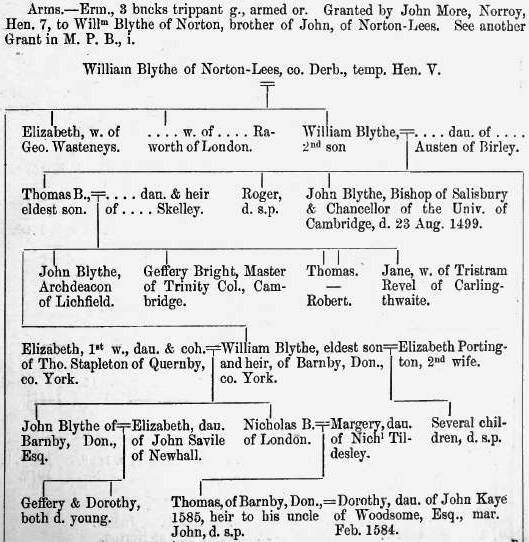
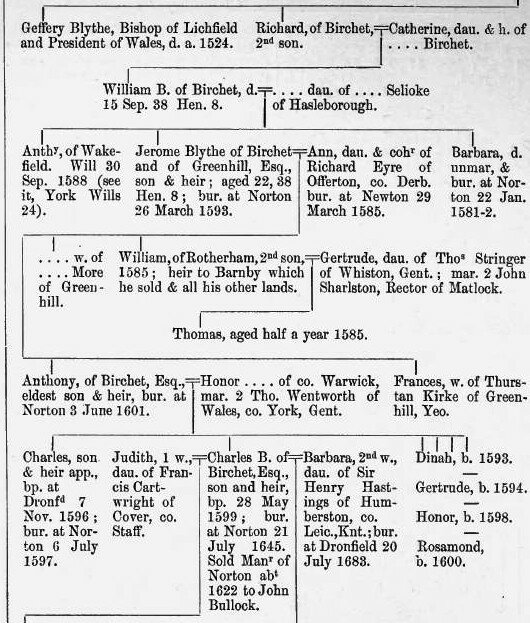
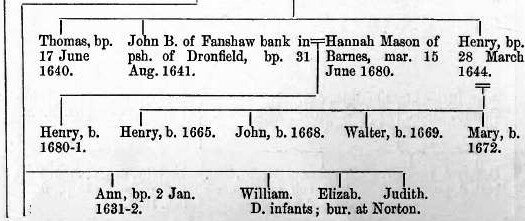
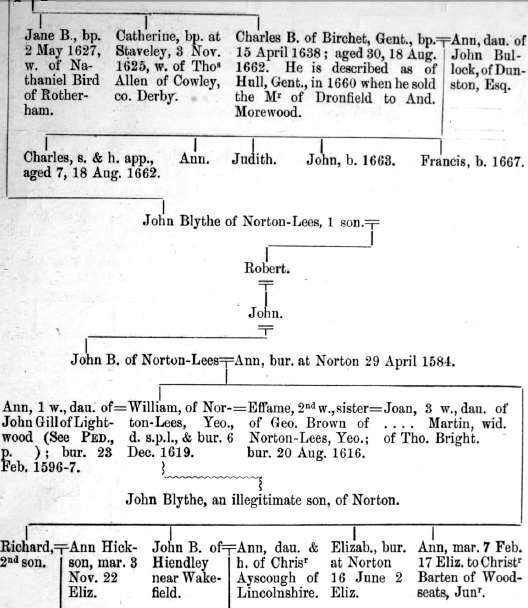
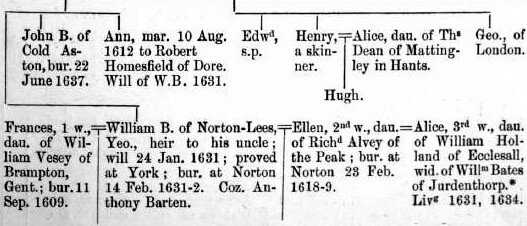
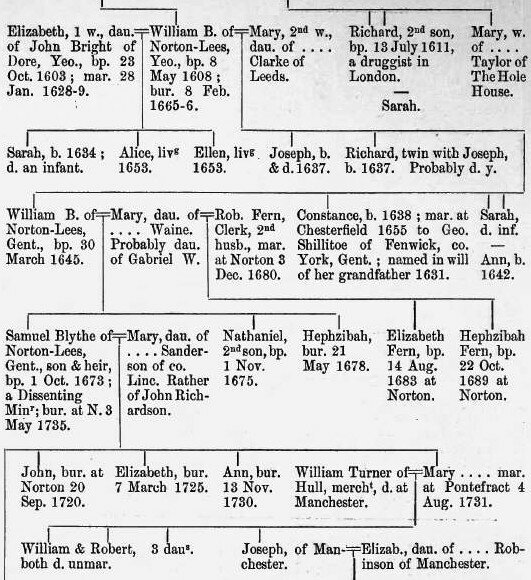

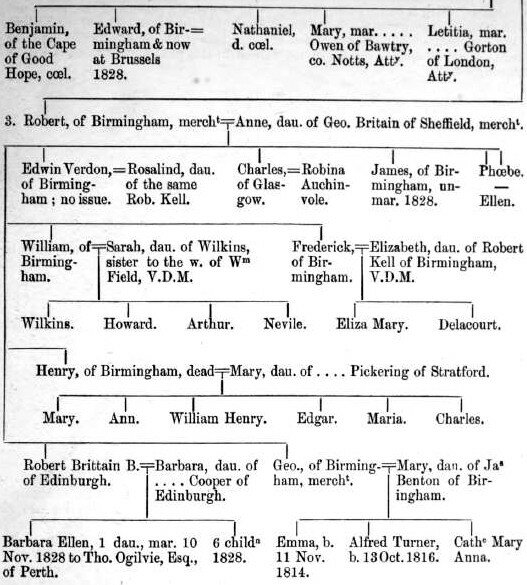
At Norton Lees the Blythes were quite evidently the dominant family
Bishop's House and the Blythe family
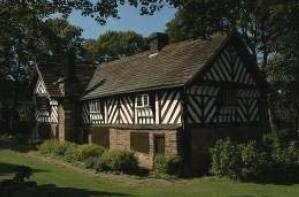
It is not clear who built Bishop's House.
An extract from The Old Halls, Manors and Families of Derbyshire¹ by Joseph Tilley states:
'... during the realm of Elizabeth, or, rather, at the close of the sixteenth century while the Blyths were living at Bishop's Court ...'
'...It would be worthy of notice if only as a building that has echoed with the shouts of fourteen generations; that was the seat of the Blyths for over two hundred years; that is evidence of a yeoman residence in the days of the Plantagenets; but from having been the home of two men, whose rapid rise from Priests to Bishops, with seats in the House of Peers, was almost without parallel, it becomes an object of considerable curiosity. But this curiosity is increased when it is known that the mother of these two men, is said, by different writers,- to have been a daughter of different families. . .'
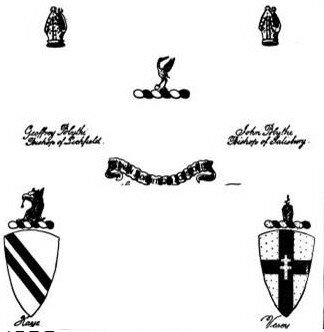
Extract² 'WE were favoured with the drawing from which the plate which adorns our presen ( number was engraved, by the kindness of È. Blore, Esq., who was pleased to express his good will towards our Miscellany, by fetching this ancient house, while on a visit in this neighbourhood. It was long the residence of a branch of a family who were in great note in the northern part of Derbyshire. Of this family were, John and Geoffrey Blythe, sons of William Blythe, of Norton, to whom a grant of arme was made in 1485. The former became bishop of Salisbury, and the latter bishop of Coventry and Litchfield. The tomb which the latter placed over the remains of his parents is still to be seen in Norton church. The received pedigrees bring the 151yth.es of Norton-Lees from Thomas Blythe, uncle to the two bishops, from whom, after several generations, sprang William Blythe, of Norton-Lees, yeoman, perhaps the builder of this house. He married to his first wife Frances Vesey, of a very ancient family, in the wapentake of Strafforth and Tickhill, daughter to William Vesey, by whom he had William Blythe, of Norton-Lees, a commander in the Parliament army, who married a Bright, and died early in 1666. He had, for a short time, a command in Sheffield Castle. His family was brought up in principles of nonconformity, and his son William Blythe obtained a licence for having divine service in his house at Norton-Lees, in the time of Charles II. His son and successor was a dissenting minister, and, residing on the estate of his ancestors, officiated in 1716 to a small congregation at Attercliffe. In the next generation the estate was sold. and is at present in the possession of Samuel Shore, Esq. of Meersbrook. '
William Blythe (d.1631), of Bishop's House, Norton, was a yeoman farmer and small business man. He made money by farming his land and hiring out premises and equipment to make scythes. He died in 1631 and was succeeded by his son who was captain of the parliamentary army that took part in the demolition of Sheffield Castle.
Bishops House was sold to William Shore in 1753 after the death of Samuel Blythe.
Monument in Norton Church
³ The monument to William Blythe and his wife (the daughter of an Austin, of Birley) in Norton Church was erected by their son Geoffrey, the Bishop, about 1524. It is in the south aisle or chapel of the chancel. This memorial is beautifully designed, and is formed of slabs of alabaster, with two effigies of that material reclining on the surface. The man is clad in the long robes of a civilian, with full sleeves, and his head, which rests upon a cushion, is uncovered. Under the right arm is a bag or scrip, and the feet rest upon a dog. The woman wears a closefitting robe, and has upon her head the head-dress with falling lappets, usually worn by ladies at the close of the fifteenth century. The sides of this monument are enriched with figure- in bas-relief under elaborately crocketed canopies. There are seven figures on the north side, now much mutilated, but they appear to have been angels holding shields before them ; the other side is almost entirely hidden by an elevated mass of masonry which covers the Shore vault. Some of the coats of arms can be still deciphered. On the north side are three cinquefoils between nine cross crosslets fitchy (Austin), and, per pale, gu. and arg., a cross potent counterpotent and quadrate between four crosses patty counterchanged (See of Lichfield), impaling, erm., three roebucks trippant, gu attired, or (Blythe). On the other side is Blythe repeated, and a coat impaling Blythe, of which the small fragment that is left seems to be a diminutive cross, but it is in reality the top of a sceptre, being all that remains of the arms of the See of Salisbury the Blessed Virgin and Child, in her left hand a sceptre.
Vesey
References
1.The Old Halls, Manors and Families of Derbyshire, Volume 2 (1899) by Joseph Tilley
2. The Northern star, or, Yorkshire magazine, Volume 2, No. 9. FEBRUARy, 1818 edited by Arthur Jewitt
3. Notes on the Churches of Derbyshire by J. Charles Cox
You should always verify information from this and other websites, by checking the primary source, census returns, birth certificates etc.
Site Map ·About · Privacy Policy · · ©